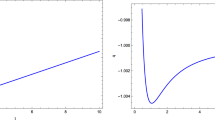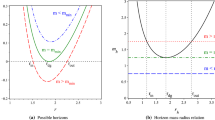Abstract
f(T) gravity, a generally modified teleparallel gravity, has become very popular in recent times, as it is able to reproduce the unification of inflation and late-time acceleration without the need of a dark energy component or an inflation field. In this present work, we investigate specifically the range of validity of Birkhoff’s theorem with the general tetrad field via perturbative approach. At zero order, Birkhoff’s theorem is valid and the solution is the well known Schwarzschild–(A)dS metric. Then considering the special case of the diagonal tetrad field, we present a new spherically symmetric solution in the frame of f(T) gravity up to the perturbative order. The results with the diagonal tetrad field satisfy the physical equivalence between the Jordan and the so-called Einstein frames, which are realized via conformal transformation, at least up to the first perturbative order.
Similar content being viewed by others
References
A. Einstein, Sitzungsber. Preuss. Akad. Wiss. Phys. Math. Kl. 217 (1928)
A. Einstein, Sitzungsber. Preuss. Akad. Wiss. Phys. Math. Kl. 224 (1928)
R. Aldrovandi, J.G. Pereira, An introduction to teleparallel gravity Instituto de Fisica Teorica, UNSEP, Sao Paulo. http://www.ift.unesp.br/gcg/tele.pdf (2007)
J. Garechi, arXiv:1010.2654 (2010)
S. Nojiri, S.D. Odintsov, Gen. Relativ. Gravit. 36, 1765–1780 (2004)
S. Nojiri, S.D. Odintsov, Phys. Rep. 505, 59–144 (2011)
S. Nojiri, S.D. Odintsov, Int. J. Geom. Methods Mod. Phys. 4, 115 (2007)
M. Li et al., Commun. Theor. Phys. 56, 525–604 (2011)
X.H. Meng, P. Wang, Class. Quantum Gravity 20, 4949 (2003)
X.H. Meng, P. Wang, Class. Quantum Gravity 21, 951 (2004)
X.H. Meng, P. Wang, Class. Quantum Gravity 21, 2029 (2004)
X.H. Meng, P. Wang, Class. Quantum Gravity 22, 23 (2005)
X.H. Meng, P. Wang, Gen. Relativ. Gravit. 36, 1947 (2004)
X.H. Meng, P. Wang, Phys. Lett. B 584, 1 (2004)
P. Wang, X.H. Meng, Class. Quantum Gravity 22, 283 (2005)
J. Ren, X.H. Meng, Phys. Lett. B 633, 1 (2006)
J. Ren, X.H. Meng, Phys. Lett. B 636, 5 (2006)
M.G. Hu, X.H. Meng, Phys. Lett. B 635, 186 (2006)
J. Ren, X.H. Meng, Int. J. Mod. Phys. D 16, 1341 (2007)
E. Flanagan, Class. Quantum Gravity 21, 417 (2003)
S. Nojiri, S. Odintsov, Phys. Lett. B 576, 5 (2003)
S. Nojiri, S. Odintsov, Phys. Rev. D 68, 123512 (2003)
D. Volink, Phys. Rev. D 68, 063510 (2003)
S. Capozziello, M. Francaviglia, Gen. Relativ. Gravit. 40, 357 (2008)
T. Sotiriou, V. Faraoni, Rev. Mod. Phys. 82, 451–497 (2010)
A. De Felice, S. Tsujikawa, Living Rev. Relativ. 13, 3 (2010)
X.-h. Meng, X.-l. Du, Phys. Lett. B 710, 493–499 (2012)
X.-h. Meng, X.-l. Du, Commun. Theor. Phys. 57, 227 (2012)
W. Hu, I. Sawicky, Phys. Rev. D 76, 064004 (2007)
S. Appleby, R. Battye, Phys. Lett. B 654, 7–12 (2007)
A.A. Starobinsky, JETP Lett. 86, 157–163 (2007)
R. Ferraro, F. Fiorini, Phys. Rev. D 75, 084031 (2007)
G.R. Bengochea, R. Ferraro, Phys. Rev. D 79, 124019 (2009)
E.V. Linder, Phys. Rev. D 81, 127301 (2010)
B.J. Li, T.P. Sotiriou, J.D. Barrow, Phys. Rev. D 83, 064035 (2011)
R.J. Yang, Eur. Phys. Lett. 93, 60001 (2011)
X.-h. Meng, Y.-b. Wang, Eur. Phys. J. C 71, 1755 (2011)
H. Dong, Y.-b. Wang, X.-h. Meng, Eur. Phys. J. C 72, 2002 (2012)
R. Myrzakulov, arXiv:1006.1120 (2010)
R.J. Yang, Eur. Phys. J. C 71, 1797 (2011)
G.R. Bengochea, Phys. Lett. B 695, 405–411 (2011)
P. Wu, H. Yu, Phys. Lett. B 693, 415–420 (2010)
P. Wu, H. Yu, Phys. Lett. B 692, 176 (2010)
B. Li, T.P. Sotiriou, J.D. Barrow, Phys. Rev. D 83, 104017 (2011)
T.P. Sotiriou, B. Li, J.D. Barrow, Phys. Rev. D 83, 104030 (2011)
C.G. Böhmer, A. Mussa, N. Tamanini, arXiv:1107.4455v2 (2011)
Y.F. Cai, S.H. Chen, J.B. Dent, S. Dutta, E.N. Saridakis, arXiv:1104.4349 (2011)
S.H. Chen et al., Phys. Rev. D 83, 023508 (2011)
J.B. Dent, S. Dutta, E.N. Saridakis, J. Cosmol. Astropart. Phys. 1101, 009 (2011)
Y.-F. Cai et al., Class. Quantum Gravity 28, 215011 (2011)
K. Bamba et al., J. Cosmol. Astropart. Phys. 1101, 021 (2011)
K. Bamba et al., arXiv:1008.4036 (2010)
K.K. Yerzhanov et al., arXiv:1006.3879 (2010)
M. Hamani Daouda et al., Eur. Phys. J. C 71, 1817 (2011)
M. Hamani Daouda et al., Eur. Phys. J. C 72, 1890 (2012)
N. Tamanini, C.G. Böhmer, arXiv:1204.4593 (2012)
K. Bamba, S. Capozziello, S. Nojiri, S. Odintsov, arXiv:1205.3421 (2012)
G.D. Birkhoff, Relativity and Modern Physics (Harvard University Press, Cambridge, 1923), pp. 4, 5, 11
S. Deser, J. Franklin, Am. J. Phys. 73, 261 (2005)
N.V. Johansen, F. Ravndal, Gen. Relativ. Gravit. 38, 537 (2006)
S. Deser, Gen. Relativ. Gravit. 37, 2251 (2005)
S. Weinberg, Gravitation and Cosmology (Wiley, New York, 1972)
V. Faraoni, Phys. Rev. D 81, 044002 (2010)
S. Capozziello, A. Stabile, A. Troisi, Phys. Rev. D 76, 104019 (2007)
S. Capozziello, D. Sáez-Gómez, arXiv:1107.0948 (2011)
G.D. Birkhoff, Relativity and Modern Physics (Harvard University Press, Cambridge, 1923), pp. 4, 5, 11
J.T. Jebsen, Ark. Mat. Ast. Fys. 15(18), 1–9 (1921)
Acknowledgements
This work is partly supported by National Natural Science Foundation of China under Grant Nos. 11075078 and 10675062 and by the project of knowledge Innovation Program (PKIP) of Chinese Academy of Sciences (CAS) under the grant No. KJCX2.YW.W10 through the KITPC where we have initiated this present work. Xin He Meng would also like to thank Prof. Lewis H. Ryder and Prof. Sergei D. Odintsov for helpful discussions, and to dedicate this work to remember one of his teachers once working in Tucson, USA, who has inspired him for exploring the truth, beauty, fairness and justice of this world forever!
Author information
Authors and Affiliations
Corresponding author
Appendix
Appendix
Here, we deduce in detail the variation of the action for a simply scalar torsion T with respect to vierbein. Considering the basic relation e α i e β i=δ α β in teleparallel gravity, we can define the algebraic complement C α i of e α i,


So we get C α i =ee α i and the variation of metric with respect to e α i

and

Redefining the energy–momentum tensor formula of e α i and \(e = \sqrt{-g}\)

Maybe a more suitable form for this work is

Differing from that in Einstein’s theory of general relativity, teleparallel gravity uses Weitzenböck connection, defined directly from the vierbein (3) and antisymmetric non-vanishing torsion (4).
Then we can deduce the variation of the torsion tensor with respect to e α i and ∂ μ e α i, respectively,


and the coupling with \(\tilde{\partial}^{\mu}\varphi\)

The other two tensors are defined by (6) and (7). Then the torsion scalar as the teleparallel Lagrangian is defined by (8). One needs to pay attention to the S ρ μν being a polynomial combination of the product of g μν and T ρ μν , like
The indices a,b,c,d,e of the above definition are dummy indices. After summation of these five dummy indices, only ρ,μ,ν are left. Then we can use a step-by-step method for the binomial formula to deduce the variation of the torsion scalar with respect to e α i and ∂ μ e α i, respectively,

and

Finally, we can get the variation equation (11) of the action (10) with respect to the vierbein.
Rights and permissions
About this article
Cite this article
Dong, H., Wang, Yb. & Meng, Xh. Birkhoff’s theorem in f(T) gravity up to the perturbative order. Eur. Phys. J. C 72, 2201 (2012). https://doi.org/10.1140/epjc/s10052-012-2201-0
Received:
Revised:
Published:
DOI: https://doi.org/10.1140/epjc/s10052-012-2201-0




